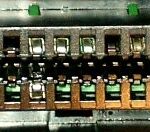Experiencing a no communication error with your OBD2 scanner on a 96 Dodge Ram can be a frustrating roadblock, especially when you’re trying to diagnose engine or transmission issues. This article will guide you through the common causes and diagnostic steps to resolve this problem, ensuring you can get your Ram back on the road.
Understanding OBD2 Communication Problems in Your 96 Dodge Ram
The On-Board Diagnostics II (OBD2) system is crucial for modern vehicle diagnostics. It allows mechanics and owners to read trouble codes, monitor engine parameters, and ensure the vehicle is running efficiently. However, if your scanner fails to connect, pinpointing problems becomes significantly harder. For 96 Dodge Rams, a no communication issue at the OBD2 port can stem from several sources, ranging from simple fuse problems to more complex PCM (Powertrain Control Module) failures.
Diagnosing the “No Communication” Issue
Before assuming a major component failure, start with these basic checks:
1. Inspect the OBD2 Port and Fuses
The first step is to physically inspect the OBD2 port for any damage or corrosion. Ensure the port is clean and the pins are not bent or broken. Next, check the fuses related to the OBD2 system and the PCM. A blown fuse is a common cause of no communication. Refer to your Dodge Ram’s owner’s manual or a wiring diagram to locate the relevant fuses in the power distribution center (PDC).
2. Verify Power and Ground at the OBD2 Port
The OBD2 port requires power and ground to operate. Use a multimeter to check for voltage at pin 16 (Battery Voltage) and ground at pins 4 and 5 (Chassis Ground and Signal Ground). If you are missing power or ground, trace the wiring back to the power source or ground point to identify any breaks or shorts in the circuit.
3. Check Wiring Between the OBD2 Port and PCM
Communication between the OBD2 port and the PCM relies on specific wires. For a 96 Dodge Ram, these typically include communication lines like the VPW (Variable Pulse Width Modulation) or similar protocols depending on the specific engine and PCM. Using a wiring diagram, check the continuity of these wires between the OBD2 port connector and the PCM connector. Look for open circuits or shorts to ground that could be disrupting communication. In the original post, the user mentioned checking violet and blk/white wires, which aligns with typical diagnostic steps for communication circuits.
4. Consider PCM Issues
If power, ground, and wiring all check out, the PCM itself may be the source of the problem. The PCM is the central computer that controls the OBD2 communication. A faulty PCM may not respond to scanner requests. While PCM failure is less common than wiring or fuse issues, it’s a possibility, especially in older vehicles like a 96 Dodge Ram. Before replacing the PCM, consider having it tested professionally to confirm the diagnosis.
Addressing Transmission Problems Alongside OBD2 Communication
The original poster mentioned transmission issues alongside the OBD2 communication problem. While seemingly separate, they could be indirectly related if the PCM is failing. A malfunctioning PCM can cause both a lack of OBD2 communication and erratic transmission behavior. If you’re experiencing both, a thorough PCM diagnosis is even more critical.
Conclusion: Step-by-Step Troubleshooting is Key
Diagnosing a “96 Dodge Ram No Communication At Obd2” issue requires a systematic approach. Start with the simple checks like fuses and port inspection, then move to wiring and power verification. If those steps don’t reveal the problem, consider the PCM as a potential culprit. By following these diagnostic steps, you can effectively troubleshoot and resolve the no communication issue, allowing you to properly diagnose any underlying problems with your 96 Dodge Ram. Remember, if you are uncomfortable with electrical diagnostics, seeking professional help from a qualified mechanic is always a prudent step.
